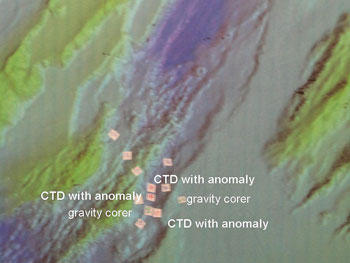Day 9 - 3 July
We have now completed three CTDs that indicate anomalies, and several that indicate nothing, enabling us to pin down the potentially "interesting" area more closely (please see map).
Main content
Position: 73N 8E
Temperature: 5.9 (air) 7.0 (water)
Wind speed: 7.3m/s
Wave height: 1.2m (average)
Visibility: good
Weather: overcast
The scientists have been analysing yesterday's core samples for levels of reduced materials such as hydrogen sulphide and methane that would indicate the possible presence of a hydrothermal vent. Microbiologial tests have been conducted on dilutions of the sediment material to start to build a DNA library of the organisms found in these sediments.
Yesterday the Norwegian coast Guard flew out from Svalbard and dropped off a package with spare parts for the ROV. Today we set out the newly repaired ROV down to 2900m - the deepest dive ever by a Norwegian ROV. We think we may have reached the bottom in the deepest part of the rift valley.
The sea-floor here was covered in fine, light coloured sand. There were some animals - sea anemones, a grenadier fish and a few other fish. There was also a tremendous amount of marine snow of a more or less constant density all the way down, indicating that these cold northern waters are far from sterile environments.
Unfortunately, on the way up the ROV cable became tangled. However, after some hours, the GOSars crew did a fantastic job of bringing the knotted cable on board and retrieving the ROV safely.
